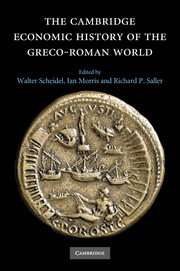Book contents
- Frontmatter
- 1 Introduction
- Part I Determinants of Economic Performance
- Part II Early Mediterranean Economies and the Near East
- 7 The Aegean Bronze Age
- 8 Early Iron Age Greece
- 9 The Iron Age in the Western Mediterranean
- 10 Archaic Greece
- 11 The Persian Near East
- Part III Classical Greece
- Part IV The Hellenistic States
- Part V Early Italy and the Roman Republic
- Part VI The Early Roman Empire
- Part VII Regional Development in the Roman Empire
- Part VIII Epilogue
- Bibliography
- Index
- Map 1.1 The Mediterranean basin"
- Map 10.1 Greek and Phoenician trade in the period of the Persian Wars"
- Map 11.1 The Achaemenid empire"
- Map 12.1 Greece and Asia Minor"
- Map 15.1 The Seleucid empire"
- Map 16.1 Greco-Roman Egypt"
- Map 20.1 The Roman empire at the accession of Vespasian"
- References
7 - The Aegean Bronze Age
from Part II - Early Mediterranean Economies and the Near East
Published online by Cambridge University Press: 28 March 2008
- Frontmatter
- 1 Introduction
- Part I Determinants of Economic Performance
- Part II Early Mediterranean Economies and the Near East
- 7 The Aegean Bronze Age
- 8 Early Iron Age Greece
- 9 The Iron Age in the Western Mediterranean
- 10 Archaic Greece
- 11 The Persian Near East
- Part III Classical Greece
- Part IV The Hellenistic States
- Part V Early Italy and the Roman Republic
- Part VI The Early Roman Empire
- Part VII Regional Development in the Roman Empire
- Part VIII Epilogue
- Bibliography
- Index
- Map 1.1 The Mediterranean basin"
- Map 10.1 Greek and Phoenician trade in the period of the Persian Wars"
- Map 11.1 The Achaemenid empire"
- Map 12.1 Greece and Asia Minor"
- Map 15.1 The Seleucid empire"
- Map 16.1 Greco-Roman Egypt"
- Map 20.1 The Roman empire at the accession of Vespasian"
- References
Summary
introduction
In this chapter, I explore economic activity in the Aegean Bronze Age (c. 3000–1000 bc). I focus on the “palatial” societies of Late Bronze Age Crete and mainland Greece, but offer an outline of prior developments, on which they were based. I emphasize what might be termed the “core” of the Mycenaean world (mainland Greece from southern Thessaly to the southern Peloponnese, the islands of the Aegean, including Crete, plus much of coastal southwest Anatolia). Such a definition is just as deficient for the Bronze Age as it is for the Early Iron Age and later, since it does not “bound” the world in which inhabitants of the Bronze Age Aegean moved or with which they were in contact, as will become apparent in the discussion of exchange.
It is a commonplace to emphasize the agricultural basis for all ancient societies and, for five millennia, this was true of the Aegean region. The standard western Old World cultigens (wheat, barley, and pulses) and domesticated animals (sheep, goats, pigs, and cattle) arrived by 7000 bc (with or without people), in eastern mainland Greece and on Crete, at least at Knossos. For Crete, lack of evidence for prior human settlement strongly suggests deliberate colonization at that time, probably from southwest Anatolia. The Bronze Age in the Aegean officially begins late in the fourth millennium bc, although metalworking is quite common before this, and regular use of tin bronze relatively rare before the later third millennium. By 3000 bc permanent human populations practicing agriculture had reached all but the tiniest Aegean islands, facilitating the formation of an interaction zone comprising the eastern Greek mainland, the northern Aegean, western Anatolia, and Crete.
- Type
- Chapter
- Information
- The Cambridge Economic History of the Greco-Roman World , pp. 173 - 210Publisher: Cambridge University PressPrint publication year: 2007
References
- 10
- Cited by



